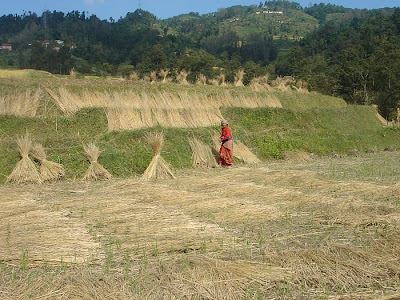Kathmandu
----------------
Now playing: Michael Stearns - Opening / Nepal Morning
via FoxyTunes
World food shortages and skyrocketing food prices have been in the news a lot lately. In a primarily agricultural country like Nepal, I read things like this and wonder how it got that way.
What kind of convoluted system of subsidies, trade agreements (or
 disagreements), embargos, poor planning, population increase and price-fixing results in a place like Nepal (terraced rice fields everywhere) not having enough rice? My friend Brother Martin knows a lot more about this stuff than I do (at least in the American context).
disagreements), embargos, poor planning, population increase and price-fixing results in a place like Nepal (terraced rice fields everywhere) not having enough rice? My friend Brother Martin knows a lot more about this stuff than I do (at least in the American context).It also leaves me wondering how people (in places like Ladakh, as well, where rice definitely does not grow and every grain has to be "imported" up the Leh-Manalai Highway from lower India) have become so dependent on white rice.
In Nepal, there are lots of locally grown alternatives...buckwheat ("dhido"), barley ("tsampa") and corn maize ("aato"). Tsampa grows best in Ladakh, along with millet and several varieties of fast-growing wheat.
It's become a downmarket thing in Nepal to eat Dhido - according to Culture Shock: Nepal people don't even like to admit having a
 taste for buckwheat. I've only ever seen it served in one restaurant, and I had to special order it.
taste for buckwheat. I've only ever seen it served in one restaurant, and I had to special order it.And before some know it all writes in and says "Corn is not an Asian crop" --I know that.... but it does grow darn near everywhere here now. Literally every vacant lot in urban Kathmandu seems to be sprouting corn sometimes. I will leave it for someone else to decry the effects of introducing a non-native crop.
According to this IRIN News report, India banned export of the cheap rice. It might make sense to ban exporting it to western countries, but to Nepal, the poorest nation in SAARC?
Nepal has been largely dependent on low-cost rice and vegetables from India. The ban on exports since October 2007 of non-Basmati (cheap) rice from India had caused a huge problem, said Ragan. According to local traders, India's supplies roughly meet 25 percent of Nepal's food requirements.
The Ministry of Agriculture estimated that the production of summer paddy would be 17 percent higher this year, but it is likely that rice prices will still increase by over 20 percent because of the lack of food imports from India, according to WFP.
The government's Central Bank of Nepal estimated that the price of rice had increased by over 30 percent in the last three months. However, owing to lower incomes, people in remote hilly areas were most exposed to the price hikes.
...."The cost of rice has increased from Rs 5,000 [$80] to Rs 8,000 [$127] for a 100kg sack. Just imagine our hardship," said Sunita Chettri from Dolpa.
And if anyone has an answer to every diet-conscious traveller in Asia's constant question - that is, whatever happened to natural, nutritious brown rice instead of refined white rice? - please tell me!














No comments:
Post a Comment